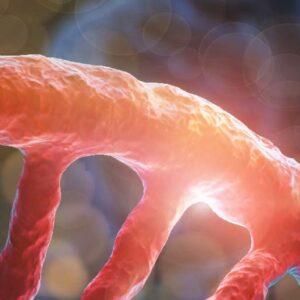Brugada syndrome (BrS) is one of the most common causes of sudden cardiac death (SCD) and is responsible for about 20% of cases involving a structurally unrecognizable heart. It is an autosomal dominant inherited disease with incomplete penetrance and genetic heterogeneity. The average frequency worldwide is 1:5-10,000, with men being affected about eight to ten times more frequently. The first symptoms can occur in early childhood, although they typically occur at the age of 30-40 years. A characteristic feature of BrS is the ST segment elevation persisting in the right precordial ECG lead (BrS type I ECG), which in some cases can only be unmasked by antiarrythmic drugs such as ajmalin or flecainide.
In Brugada syndrome there is a predisposition to rapid polymorphic ventricular tachycardia and ventricular fibrillation. The symptoms often occur at night and often lead to sudden cardiac death. The risk of sudden cardiac death is 2-15% per year depending on the clinical symptoms. Current guidelines recommend ICD implantation in all BrS patients with previous arrythmia-related symptoms. Additional treatment with quinidine has been shown to be useful in patients with multiple ICD shocks and electrical storms or in children at risk. In high-risk patients, catheter ablation (e.g., of the epicardium of the right ventricular outflow tract) should be considered, which not only reduces the occurrence of arrythmias, but can also eliminates the BrS-typical ECG pattern.
In up to 25% of cases, pathogenic variants can be detected in the SCN5A gene (sodium channel Nav1.5), which lead to a reduction of the inwardly directed sodium flow and consequently to BrS type 1. In 1-10% of cases with a BrS type I ECG, other forms of Brugada syndrome are present. Some patients carry pathogenic variants in the calcium ion channel genes CACNA1C (alpha-1C subunit, Ca channel, Cav1.2, BrS3) and CACNB2 (beta-2 subunit, BrS4). In addition to ST segment elevation, these variants result in relatively short QTc of 330‑370 ms. Some forms are very rare and therefore not part of routine diagnostics. In about 70% of all cases of Brugada syndrome, no pathogenic variant can be detected. The combination of frequent polymorphisms seems to be associated with an up to 20-fold increased risk of Brugada syndrome.
References
Al-Khatib et al. 2018, Circulation 138:e210 / Hosseini et al. 2018, Circulation 138:1195 / Delise et al. 2017, World J Cardiol 9:737 / Schulze-Bahr et al. 2015, Kardiologe DOI 10.1007/s12181-014-0636-2 / Steinfurt et al. 2015, Dtsch Arztebl Int 112:394 / Le Scouarnec et al. 2015, Hum Mol epub 3. Feb / Behr et al. 2015, Cardiovasc Res epub 17. Feb / Hu et al. 2014, J Am Coll Cardiol 64:66 / Bezzina et al. 2013, Nat Genet 45:1044 / Nielsen et al. 2013, Front Physiol 4:179 / Crotti et al. 2013, J Am Coll Cardiol 60:1410 / Kaufmann et al. 2012, J Am Coll Cardiol 60:1419 / Ackerman et al. 2011, Europace 13:1077 / Hedley et al. 2009, Hum Mutat 30:1256 / Antzelevitch et al. 2008, Curr Cardiol Rep 10:376 / Priori et al. 2002, Circulation 105:1342 / Brugada et al. 1992, Am Coll Cardiol 20:1391





















